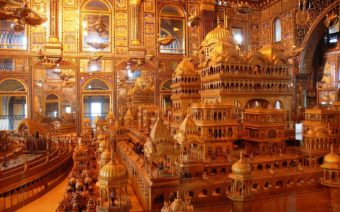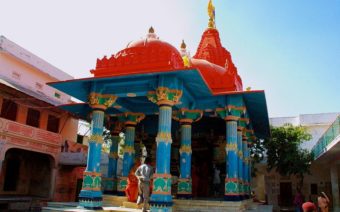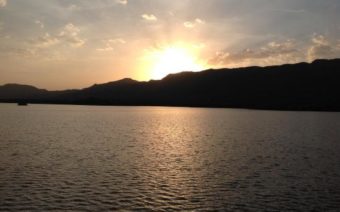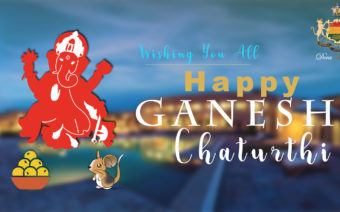
The Ajmer Jain temple, also known as Soniji Ki Nasiyan, is an architecturally rich Jain temple. It was built in the late nineteenth century. The main chamber, known as the Swarna Nagari “City of Gold”, has several gold-plated wooden figures, depicting several figures in the Jain religion. Greatly revered by the Digambar sect of the Jains, the Nasiyan temple is dedicated to Lord Rishabhdev, first of the 24 tirthankara by Rai Bahadur Seth Moolchand and Nemichand Soni. It is situated on Prithvi Raj Marg in Ajmer, the heart of Rajasthan state in India. The foundation of this magnificent Jain temple was laid on 10 October 1864 and the image of the first Tirthankar Lord Rishabhdev (Adinath), was installed in the Sanctum Sanctorum on 26 May 1865. This work was carried out under the able guidance of the great scholar Pandit Sadasukhdasji of Jaipur. But the hidden gem in Ajmer is Soniji Ki Nasiyan aka Lal mandir that was built over 100+ years back by a rich Jain businessman or a Seth. What you see here is a huge hall 90 ft X 65 ft X 92 ft in dimension, with a diorama of a complete Jain city Ayodhya Nagari. At the time of the birth of a Jain saint Adinath. There is a complete 3 storied palace built with scenes depicting the life of the city. The huge armies of elephants and horses are depicted on the ground. There are devas or demigods on their planes coming to visit the earth at the city of Ayodhya made holy by the birth of the saint Adinath. The walls adorn the glass paintings showing scenes and stories from the Jain scriptures.
The whole aura is of grandeur, divinity, and celebration. It is said that the models were created and showcased in Jaipur before they were brought here. You can view this huge piece of sculpture only through a small opening in the walls of the hall. And that too through a glass. But for the security reasons, you want to step inside and feel like how a literally golden city would be. For some reason, I had never heard of this place until I actually landed in front of it. This was the hidden surprise of this trip of mine.
Lake Foy Sagar is an artificial lake situated near Ajmer in the state of Rajasthan, India. It is named after the engineer Mr. Foy, an Englishman, who created it under a famine relief project in 1892. He created it to tackle with harshest conditions of famine under a famine relief project. It appears flat and offers views of the neighboring Aravalli mountains. The lake is among the tourist spots of the city.
At the time when the lake was constructed, the city of Ajmer was known as Ajmere, as can be noticed from the inscription installed at the lake. Its original capacity is 15 million cubic feet, and the water is spread over 14,000,000 square feet (1,300,000 m2). Ajmer was called Ajmere when it was made with a specific purpose, which is now a well-known tourist spot. The place is a famous picnic spot for the local residents during winters.

Pushkar is a town bordering the Thar Desert, in the northeastern Indian state of Rajasthan. It’s set on Pushkar Lake, a sacred Hindu site with 52 ghats (stone staircases) where pilgrims bathe. The town has hundreds of temples, including 14th-century Jagatpita Brahma Mandir, dedicated to the God of creation, which has a distinctive red spire and walls inlaid with pilgrims’ silver coin. Its been the rare temple because it’s amongst the very few existing temples of Lord Brahma in India. It is constructed in the 14th Century and however Indian Mythology believes the origin of this temple took place 2000 years back in history.
The Temple is located close to the sacred Pushkar Lake, the temple is a highly prominent tourist attraction; with a large flock of tourists visiting it especially on the auspicious occasion
of Kartik Poornima. The architecture of the famous Brahma temple in Pushkar is an altogether marble structure and sports a Southern style of temple architecture. Built on a raised platform, the temple’s entrance which is decorated of pillared canopies has to be reached through marble steps. If you want to experience the ultimate devotion towards Lord Brahma, you should schedule your Pushkar trip between October to November. During this month, on the night of Kartik Poornima, as it is the full moon night, a religious festival is organized in honor of the Lord. During this time thousands of pilgrims take bath in the sacred lake of Pushkar. The Kartik Poornima festival also marks the start of the world renowned Pushkar Camel Fair.
Review by one of the Guests
Garvit Says:
Excellent
It was a good experience. The rooms Read more: https://zurl.co/G6Vb
Ganesh Chaturthi, also known as Vinayaka Chaturthi (Vināyaka Chaturthī) or Vinayaka Chavithi is a Hindu Festival celebrating the birth of Ganesha. A ten-day festival, it starts on the fourth day of Hindu Lunisolar calendar month Bhadrapada, which typically falls in the months of August or September of the Gregorian calendar. The festival is marked with the installation of Ganesha clay idols privately in homes, or publicly on elaborate pandals. Observations include chanting of Vedic hymns and Hindu texts such as Ganpati Upanishad, prayers and vrata(fasting). Offerings and prasadam from the daily prayers, that is distributed from the pandal to the community, include sweets such as modaka believed to be a favorite of the elephant-headed deity.
Wishing You All Very Happy Ganesh Chaturthi!







